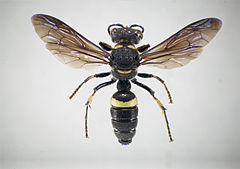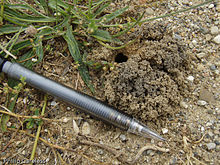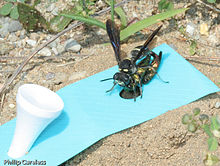- Cerceris fumipennis
-
Cerceris fumipennis 
Scientific classification Kingdom: Animalia Phylum: Arthropoda Class: Insecta Order: Hymenoptera Family: Crabronidae Genus: Cerceris Species: C. fumipennis Binomial name Cerceris fumipennis
Say, 1837Cerceris fumipennis, the only species of buprestid-hunting Crabronidae occurring in eastern North America, is found throughout the continental United States east of the Rockies: from Texas and Florida, north to Maine and Wyoming and is now known from more than twenty colonies of varying size in Canada. The wasps are most often nesting in open areas of hard-packed sandy soil surrounded by woody habitat suitable for their buprestid beetle prey. Ontario colonies are associated with somewhat disturbed sites compacted by human activity such as baseball diamonds, parking areas, infrequently used roads, roadsides, foot paths and the soil around campfire pits.
Contents
Identification
Cerceris fumipennis is distinguished by five conspicuous characteristics:
- It is large, about the size of common yellow jacket wasps.
- It has dark smoky, blue/black wings.
- The wasp’s body is predominantly black except for a few yellow markings.
- It has a conspicuous, single broad creamy yellow abdominal band.
- Females have three creamy patches between the eyes; while males are marked with two yellow triangles abutting their eyes.
Biology
Cerceris fumipennis is a solitary ground-nesting wasp. Each lone female constructs and attempts to maintain a single subterranean nest for the duration of the flight season. Her solitary nest is in close proximity to others, forming a neighborhood or informal colony of nests. The nest’s entrance is easily visible, marked by a small circular mound of earth. Each nest is composed of a single entrance hole which leads to subterranean cells. Like many crabronidae and sphecid wasps, C. fumipennis females mass provision for their cells before laying an egg in them. Adult females provision their cells with beetles of the family buprestidae.
When hunting for buprestid prey, the maximum foraging range of the wasp is estimated at 2 km with an estimated average flight distance of 750 meters from the nest. Once prey has been found, a female wasp will typically attack a target beetle by alighting on it, climbing over it, and grabbing it by the thorax with her mandibles before inserting her stinger into the base of the beetle’s leg (in the membrane of the coxal joint, a gap in the buprestid’s armour) and injecting a paralytic venom. Once at the nest entrance or in the burrow, the female wasp will sometimes re-sting poorly paralyzed prey in the same joint.
Within minutes of placing the final paralyzed beetle into its subterranean cell the adult wasp lays a single hotdog-shaped egg along the beetle’s mesosternum. Prey beetles are paralyzed, not killed, ensuring that each beetle will remain fresh until the wasp larva can begin feeding upon it. After the egg is laid, the completed cell is detached from the burrow as the female wasp backfills the access with 3 – 6 cm of soil.
Once one cell is completed the wasp begins work on the next cell by excavating in a new direction off the main burrow. Most cells (approximately 5 – 12, but up to 24) are constructed 7 – 20 cm below grade with the egg, larva and pupal stages all developing within the confines of the single nest. In Ontario, the eclosion, which equals the duration of time spent in the brood cell, is about 10 months.
Emergence dates and speed of the life cycle vary across the wasp’s broad distribution. In Ontario, the flight season typically begins the last week of June and continues until early September. Emergence dates and duration of flight season can be influenced by droughts, which could postpone emergence or shorten the flight season.
Value for Biosurveillance
In collecting buprestid prey, C. fumipennis has also been recorded collecting Emerald Ash Borer (EAB; Agrilus planipennis), a pest insect known for killing north American species of Ash trees. EAB has proven difficult to detect using traditional methods of ground/visual surveys and sticky traps, both of which are costly, labour-intensive and at times destructive or impractical. Biosurveillance, using another species to survey for a pest species, offers an alternative approach for the detection and survey of EAB populations. Preliminary studies have shown that the wasp’s EAB detection skills far surpass any comparable human technology. C. fumipennis has become a novel ally in our efforts to monitor for EAB in Canada and the United States.
References
- Careless, P.D., Marshall, S.A., Gill, B.D., Appleton, E., Favrin, R., & Kimoto, T. (2009). Cerceris fumipennis – A Biosurveillance Tool for Emerald Ash Borer. Canadian Food Inspection Agency. pp. 16.
- Cartwright, O. L. (1931). Digger wasps and Buprestidae (Hymenoptera: Cerceridae, Coleoptera: Buprestidae). Entomological News, 43, 269-270.
- Evans, H. E. (1971). Observations on the nesting behavior of wasps of the tribe Cercerini Journal of the Kansas Entomological Society, 44, 500-523.
- Evans, H. E., & Rubink, W. L. (1978). Observations on the prey and nests of seven species of Cerceris (Hymenoptera: Sphecidae). Great Basin Naturalist, 38, 59-63.
- Grossbeck, J. A. (1912). Habits of Cerceris fumipennis (say). Journal of the New York Entomological Society, 20, 135.
- Hook, A. W., & Evans, H. E. (1991). Prey and parasites of Cerceris fumipennis (Hymenoptera: Sphecidae) from central Texas, with description of the larva of Dasymutilla scaevola (Hymenoptera: Mutillidae). Journal of the Kansas Entomological Society, 64(3), 257-264.
- Kurczewski, F. E., & Miller, R. C. (1984). Observations on the nesting of three species of Cerceris (Hymenoptera: Sphecidae). Florida Entomologist, 67, 146-155.
- Marshall, S. A., Paiero, S. M., & Buck, M. (2005). Buprestid sampling at nests of Cerceris fumipennis (Hymenoptera: Crabronidae) in Southern Ontario: The first Canadian records of three buprestids (Coleoptera: Buprestidae). Canadian Entomologist, 137(4), 416-419.
- Mueller, U. G., Warneke, A. F., Grafe, T. U., & Ode, P. R. (1992). Female size and nest defense in the digger-wasp Cerceris fumipennis (Hymenoptera: Sphecidae, Philanthinae). Journal of the Kansas Entomological Society, 65(1), 44-52.
External links
Categories:- Hymenoptera of North America
- Crabronidae
Wikimedia Foundation. 2010.





